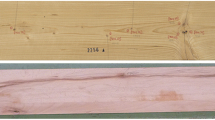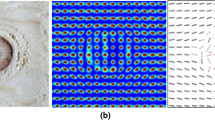Abstract
Growth irregularities such as knots always result in a pronounced reduction in strength in wooden boards. The presented paper deals with the experimental validation of a newly developed numerical simulation tool (Hackspiel et al., Wood Sci Techol, submitted, 2013) which allows the investigation of such defects by means of physically based numerical simulations. Thereby, advanced models for the description of the three-dimensional fiber course and for the mechanical material behavior are used. The stepwise validation covers the validation of the model for the elastic behavior covering the model for the grain course in the first place. For the validation of the model’s strength prediction capabilities, a total number of 52 boards were tested in tension and bending. The corresponding strength predicted by the simulation tool showed good agreement with the test results. The validated tool was then used to perform parameter studies in which the influence of various knot-related parameters on strength was investigated. The observed trends help to identify decisive knot parameters for board strength, which should receive particular attention in the grading process.











Similar content being viewed by others
References
Bader T, Hofstetter K, Hellmich Ch, Eberhardsteiner J (2010) Poromechanical scale transitions of failure stresses in wood: from the lignin to the spruce level. ZAMM: Zeitschrift für Angewandte Mathematik und Mechanik 90:750–767
Bodig F, Jayne B (1982) A mechanics of wood and wood composites. Van Nostrand Reinhold Company, New York Cincinnati Toronto London Melbourne
DIN 4074–1 (2008) Sortierung von Holz nach der Tragfähigkeit - Teil 1: Nadelschnittholz
Foley C (2003) Modeling the effects of knots in structural timber. Doctoral thesis, Lund University
Hackspiel C, De Borst K, Lukacevic M (2013) A numerical simulation tool for wood grading: model development. Wood Sci Techol (submitted for publication)
Hofstetter K, Hellmich C, Eberhardsteiner J (2005) Development and experimental validation of a continuum micromechanics model for the elasticity of wood. Eur J Mech A/Solids 24:1030–1053
Hofstetter K, Hellmich C, Eberhardsteiner J (2007) Micromechanical modeling of solid-type and plate-type deformation patterns within softwood materials. A review and an improved approach. Holzforschung 61:343–351
Kollmann F (1982) Technologie des Holzes und der Holzwerkstoffe. Springer, Berlin
Shigo AL (1990) Die neue Baumbiologie. Bernhard Thalacker, Braunschweig
Author information
Authors and Affiliations
Corresponding author
Rights and permissions
About this article
Cite this article
Hackspiel, C., de Borst, K. & Lukacevic, M. A numerical simulation tool for wood grading: model validation and parameter studies. Wood Sci Technol 48, 651–669 (2014). https://doi.org/10.1007/s00226-014-0630-7
Received:
Published:
Issue Date:
DOI: https://doi.org/10.1007/s00226-014-0630-7




